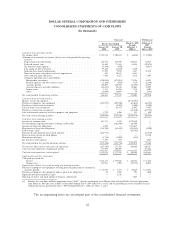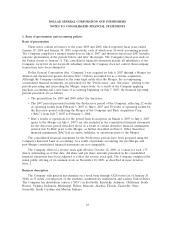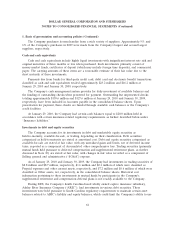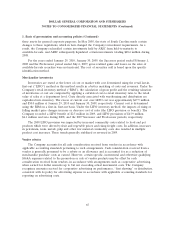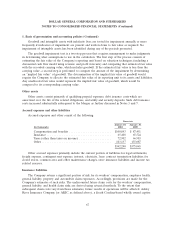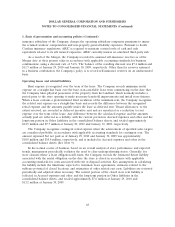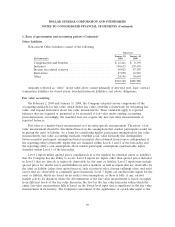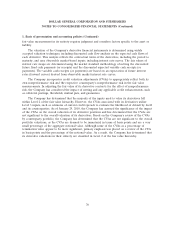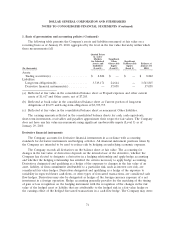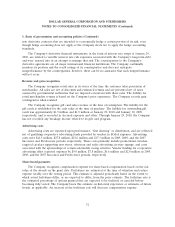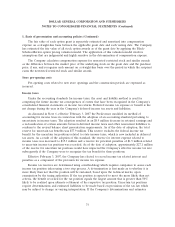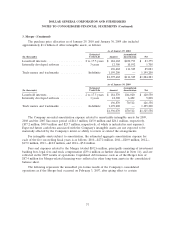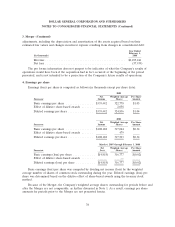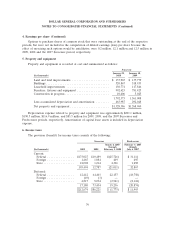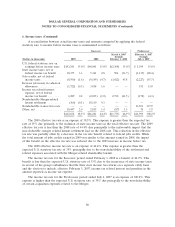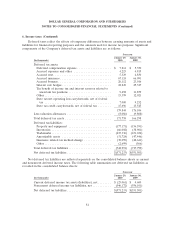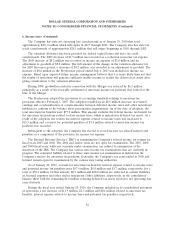Dollar General 2009 Annual Report Download - page 83
Download and view the complete annual report
Please find page 83 of the 2009 Dollar General annual report below. You can navigate through the pages in the report by either clicking on the pages listed below, or by using the keyword search tool below to find specific information within the annual report.DOLLAR GENERAL CORPORATION AND SUBSIDIARIES
NOTES TO CONSOLIDATED FINANCIAL STATEMENTS (Continued)
1. Basis of presentation and accounting policies (Continued)
into derivative contracts that are intended to economically hedge a certain portion of its risk, even
though hedge accounting does not apply or the Company elects not to apply the hedge accounting
standards.
The Company’s derivative financial instruments, in the form of interest rate swaps at January 29,
2010, are related to variable interest rate risk exposures associated with the Company’s long-term debt
and were entered into in an attempt to manage that risk. The counterparties to the Company’s
derivative agreements are all major international financial institutions. The Company continually
monitors its position and the credit ratings of its counterparties and does not anticipate
nonperformance by the counterparties, however, there can be no assurance that such nonperformance
will not occur.
Revenue and gain recognition
The Company recognizes retail sales in its stores at the time the customer takes possession of
merchandise. All sales are net of discounts and estimated returns and are presented net of taxes
assessed by governmental authorities that are imposed concurrent with those sales. The liability for
retail merchandise returns is based on the Company’s prior experience. The Company records gain
contingencies when realized.
The Company recognizes gift card sales revenue at the time of redemption. The liability for the
gift cards is established for the cash value at the time of purchase. The liability for outstanding gift
cards was approximately $1.9 million and $1.5 million at January 29, 2010 and January 30, 2009,
respectively, and is recorded in Accrued expenses and other. Through January 29, 2010, the Company
has not recorded any breakage income related to its gift card program.
Advertising costs
Advertising costs are expensed upon performance, ‘‘first showing’’ or distribution, and are reflected
net of qualifying cooperative advertising funds provided by vendors in SG&A expenses. Advertising
costs were $41.5 million, $27.8 million, $23.6 million and $17.3 million in 2009, 2008, and the 2007
Successor and Predecessor periods, respectively. These costs primarily include promotional circulars,
targeted circulars supporting new stores, television and radio advertising, in-store signage, and costs
associated with the sponsorships of certain automobile racing activities. Vendor funding for cooperative
advertising offset reported expenses by $9.0 million, $7.8 million, $6.6 million and $2.0 million in 2009,
2008, and the 2007 Successor and Predecessor periods, respectively.
Share-based payments
The Company recognizes compensation expense for share-based compensation based on the fair
value of the awards on the grant date. Forfeitures are estimated at the time of valuation and reduce
expense ratably over the vesting period. This estimate is adjusted periodically based on the extent to
which actual forfeitures differ, or are expected to differ, from the prior estimate. The forfeiture rate is
the estimated percentage of options granted that are expected to be forfeited or canceled before
becoming fully vested. The Company bases this estimate on historical experience or estimates of future
trends, as applicable. An increase in the forfeiture rate will decrease compensation expense.
72


